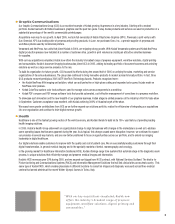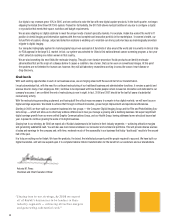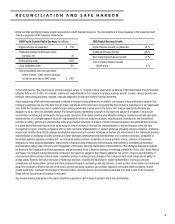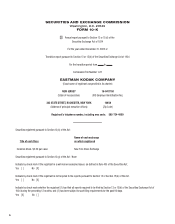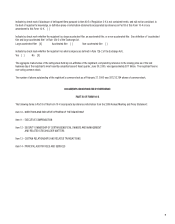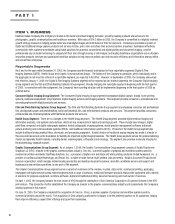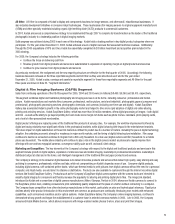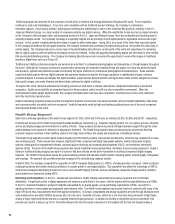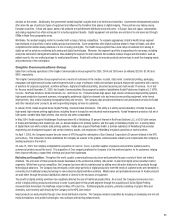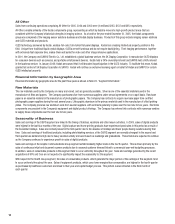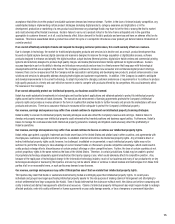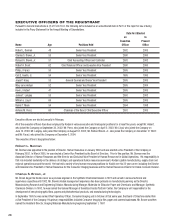Kodak 2005 Annual Report Download - page 15
Download and view the complete annual report
Please find page 15 of the 2005 Kodak annual report below. You can navigate through the pages in the report by either clicking on the pages listed below, or by using the keyword search tool below to find specific information within the annual report.
13
Research and Development
Through the years, Kodak has engaged in extensive and productive efforts in research and development.
Research and development expenditures for the Company’s three reportable segments and All Other for 2005, 2004 and 2003 were as follows:
(in millions) 2005 2004 2003
D&FIS $ 276 $ 365 $ 481
Health Group 179 202 173
Graphic Communications Group 271 118 36
All Other 166 151 70
Total $ 892 $ 836 $ 760
The downward trend in research and development expenditures in the D&FIS and Health Group segments and upward trend in the Graphic
Communications Group segment and All Other refl ects the acquisitions completed in the current year as well as a continued focus on developing digital
product areas.
Research and development is headquartered in Rochester, New York. Other U.S. groups are located in Boston, Massachusetts; Dallas, Texas;
Oakdale, Minnesota; New Haven, Connecticut; and San Jose and San Diego, California. Outside the U.S., groups are located in England, France,
Iceland, Israel, Germany, Japan, China, Singapore and Canada. These groups work in close cooperation with manufacturing units and marketing
organizations to develop new products and applications to serve both existing and new markets.
It has been Kodak’s general practice to protect its investment in research and development and its freedom to use its inventions by obtaining patents.
The ownership of these patents contributes to Kodak’s ability to provide leadership products and to generate revenue from licensing. The Company
holds portfolios of patents in several areas important to its business, including color negative fi lms, processing and papers; digital cameras and image
sensors; network photo sharing and fulfi llment; x-ray fi lms, mammography systems, computed radiography, digital radiography, photothermographic
dry printing, medical and dental image and information systems; fl exographic and lithographic printing plates and systems, digital printing workfl ow
and color management, proofi ng systems; color and black & white electrophotographic printing systems; inkjet inks, media and printing systems;
thermal dye transfer and dye sublimation printing systems; digital cinema; and organic light-emitting diodes. Each of these areas is important to
existing and emerging business opportunities that bear directly on the Company’s overall business performance.
The Company’s major products are not dependent upon one single, material patent. Rather, the technologies that underlie the Company’s products
are supported by an aggregation of patents having various remaining lives and expiration dates. There is no individual patent or group of patents the
expiration of which is expected to have a material impact on the Company’s results of operations.
Environmental Protection
Kodak is subject to various laws and governmental regulations concerning environmental matters. The U.S. federal environmental legislation and state
regulatory programs having an impact on Kodak include the Toxic Substances Control Act, the Resource Conservation and Recovery Act (RCRA), the
Clean Air Act, the Clean Water Act, the NY State Chemical Bulk Storage Regulations and the Comprehensive Environmental Response, Compensation
and Liability Act of 1980, as amended (the Superfund Law).
It is the Company’s policy to carry out its business activities in a manner consistent with sound health, safety and environmental management
practices, and to comply with applicable health, safety and environmental laws and regulations. Kodak continues to engage in a program for
environmental protection and control.
Based upon information presently available, future costs associated with environmental compliance are not expected to have a material effect on the
Company’s capital expenditures, earnings or competitive position. However, such costs could be material to results of operations in a particular future
quarter or year.
Environmental protection is further discussed in the Notes to Financial Statements, Note 11, “Commitments and Contingencies.”
Employment
At the end of 2005, the Company employed approximately 51,100 full time equivalent people, of whom approximately 25,500 were employed in the
U.S. The actual number of employees may be greater because some individuals work part time.


